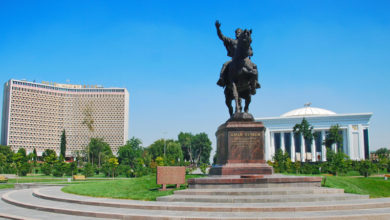Too little, too late? Washington rediscovers Central Asia

Does the recent visit by US Secretary of State Mike Pompeo to Kazakhstan and Uzbekistan signal renewed US interest in Central Asia? Maybe. The broader question is why Pompeo is seeking to engage with the region in the first place.
Central Asia remains plagued by corruption and political instability, which translates directly into business risk. Despite the attractiveness of Central Asia’s natural resources, US and EU firms remain wary of investing in the region. Given China’s significant presence, it is reasonable to ask whether the US Secretary of State’s positive investment signals are credible.
One reason for the United States to take a fresh look at Central Asia may be the emergence of incremental regional political liberalisation. The accession of the ‘Uzbek Gorbachev’ Shavkat Mirziyoyev in 2016 and the shock resignation of Kazakhstan’s Nursultan Nazarbayev in 2019 triggered a wave of optimism that a region characterised by authoritarian governments might be witnessing a partial thaw. The power transitions in both nations were achieved in an orderly fashion, indicating that Uzbek and Kazakh elites are prepared to tolerate politicians who try to lead with a more human face.
Yet limited liberalisation only partly explains US interest in Central Asia. There are few incentives for either Mirziyoyev or Kazakhstan’s new president Qasym-Zhomart Toqaev to embrace liberal democracy. The June 2019 Kazakh presidential elections were characterised by widespread irregularities. Toqaev’s predecessor Nazarbayev continues to lead Kazakhstan’s ruling party Nur Otan, chairs the Security Council and in 2019 lent his name to the national capital Nur-Sultan (formerly Astana).
Mirziyoyev has encouraged private media outlets to report on rights abuses and purged the repressive National Security Service. But Uzbekistan still ranks at 160th in the world for press freedom. Mirziyoyev has become the personification of Uzbek political power in a political system that remains highly centralised.
Pompeo’s visit shows that the Trump administration views its interests in Central Asia through the lens of pragmatic geopolitics rather than liberal ideology. Put simply, Washington’s main motivation is to try and erode growing Chinese power in the region.
One way to do this is to leverage human rights issues. After meeting with ethnic Kazakhs whose family members had been detained in Xinjiang, Pompeo called on China to end its repression of religious minorities. He identified Central Asian nations as safe havens for those ‘seeking to flee China’.
Pompeo also extended the possibility of trade and investment deals with US companies. Inviting pointed comparisons with China’s Belt and Road Initiative (BRI), Pompeo noted that when dealing with the United States ‘You get fair deals. You get job creation. You get transparency in contracts’.
Still, it is unclear how far the United States will be able to extend its influence into Central Asia. Both Brussels and Washington have sought to court the former Soviet republics on Russia’s southern flank. Kazakhstan is known for its ‘multi-vector’ foreign policy and is prepared to seek external partnerships to balance against its participation in regional integration mechanisms such as Moscow’s Eurasian Economic Union (EEU), which it joined as a founding member in 2014.
Kazakhstan has also been courted aggressively by China, receiving US$28 billion for 55 major projects. The development of the Eurasian Land Bridge also makes Kazakhstan an important transit node in China’s BRI, which will become even more crucial once Russia completes the Meridian Highway.
Central Asia is already a crowded economic and security space, where two permanent members of the UN Security Council maintain different views about how the region should evolve. Russia would like to see Central Asia as a military–security bloc supported by trade and investment partnerships that preference the EEU. But Moscow’s vision has been overtaken by China’s capacity to offer substantial investment deals.
Russia too has become reliant on Chinese investment in its energy sector. Whereas Beijing has previously been happy to pass the burden of managing regional security affairs to Moscow, it now has growing security ties to Central Asia as a result of its geoeconomic connectivity agenda.
The United States will struggle to lure Central Asian nations away from Beijing’s orbit. During Pompeo’s visit, Kazakh Foreign Minister Mukhtar Tleuberdi welcomed the potential for economic cooperation. But he pointedly declined to comment on the Uyghur issue, consistent with Kazakhstan’s policy of not criticising China’s treatment of ethnic minorities.
Pompeo’s experience in Kazahkstan is a good example of how Central Asian nations view their engagement with the United States — keen to embrace the prospect of investment and trade, but quick to separate economic issues from security or human rights issues. This is prudent for nations with consolidated authoritarian regimes that are wary of foreign policy choices that might erode their domestic authority.
The new US posture towards Central Asia will face a similar litmus test to its other efforts to blunt China’s rise in the Asia Pacific and South Asia. For instance, its announcements of an East Asia investment fund and the ‘Blue Dot Network’ have been grand in aspiration, but much more modest in terms of cash incentives. Whereas in East Asia the United States remains the dominant security actor, its economic and strategic footprint in Central Asia is much more limited.
At best, Washington’s renewed interest in Central Asia will give the region more trade options and slightly more leverage when it comes to negotiating with Beijing. At worst, it might prove to be a case of too little, too late.
Source: East Asia Forum





